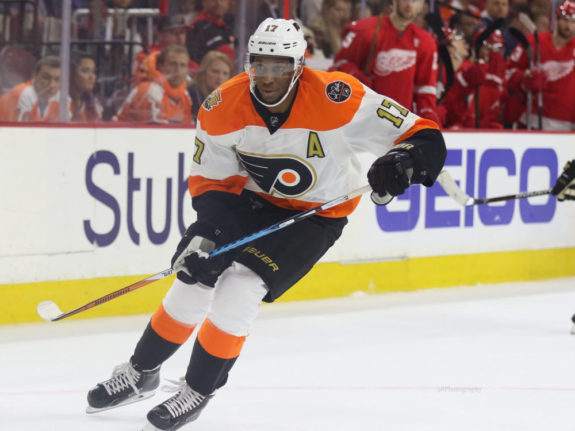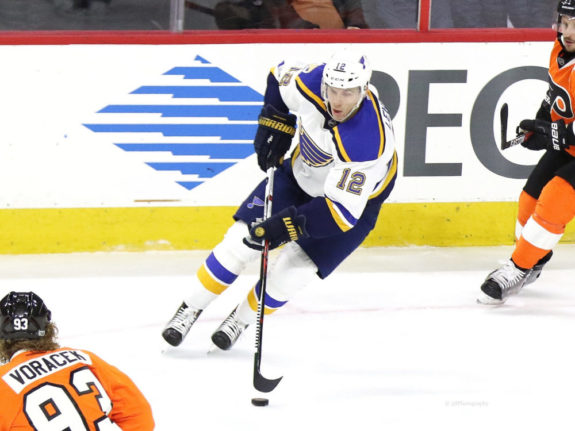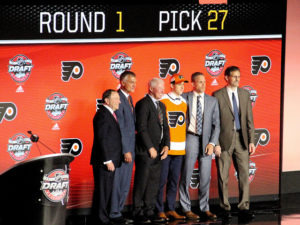June 23 is one of the most infamous days in Flyers history. Several players have fallen victim to trades on that very day. In 2011, Mike Richards and Jeff Carter were traded, 2012 saw James vanRiemsdyk hitting the road and in 2014 Scott Hartnell was shipped out to Columbus.
Flyers fans joke about the day, but things once again got serious in 2017.
On the first night of the NHL Draft, Brayden Schenn was sent to St. Louis for Jori Lehtera, a 2017 first round pick — which turned into Morgan Frost — and a 2018 conditional first round pick.

That move is questionable at best for the Flyers. Schenn has been one of the more consistent scorers on the Flyers and acquiring Lethera doesn’t really present the Flyers with a good opportunity to shed any real money off the cap. There is, of course, the notion that the team got two first round picks out of the deal, but will that make up for the void that has been left by trading Schenn?
“Only Good on the Power Play”
That single line is the most common knock on Schenn that I have heard over the past few seasons and it is one of the most asinine comments I’ve heard when referring to the scoring output of any NHLer? Since when is power play production a bad thing?
It’s not — ever. In fact, I’d almost argue that power play production is more important than even strength production. All talk about that aside, Schenn was still one of the Flyers’ most productive forwards, powerplay or not.
A lot of the debate about Schenn’s special team’s play came from the fact that he led the NHL in power play goals last season — 17 of his 25 tallies came on the man-advantage. To discount those goals just because they weren’t at even strength is almost crazy. Aside from leading the team in power play goals, Schenn also led the Flyers with seven game winners. That means he had the game winner in one out of every four games the Flyers won in regulation or overtime. The next closest was Wayne Simmonds with four.

Aside from that, there was a lot to be said about Schenn’s even strength play as well.
You may be surprised, but Schenn had 19 even strength assists this season, which was second on the team only to Jakub Voracek. He also finished third on the team in points behind only Giroux and Voracek. This marked the second straight season in which Schenn had north of 50 points, the fourth consecutive in which he’s had more than 40 points and the third season out of his last four that he’s had over 20 goals.
All of this came while the Flyers had Schenn at a relatively decent cap hit — three seasons at a $5.1 million. That’s not too shabby for a guy who could most certainly tip 60 points this upcoming season. That’s also a risky tradeoff considering the Flyers just inherited a player whose numbers have been on a landslide since his first season in the NHL and has nearly the same cap hit.
That being said, this trade really wasn’t about acquiring Lehtera but was more about looking toward the future of the team.
Return on Investment
When we talk about investing, were usually doing so in reference to stocks, bonds or something to do with retirement. We’re not usually talking about a hockey trade. However, that is what this entire trade is all about.
It’s not about shedding salary, it wasn’t about an underperforming player and it wasn’t about Lehtera — it was about the two draft picks the Flyers acquired from the Blues.

The problem with that is that those draft picks represent very big unknowns.
The first of those picks turned out to be Morgan Frost.

You can read the scouting report on him from The Hockey Writers, but it essentially says he is predicted to be mid to bottom-six role player. The Flyers could use some help in that department, but his production will likely never come close to where Schenn is at now. Also, keep in mind that he was projected to go around 40-45 in the draft — the Flyers took him at 27th.
The next thing to take into consideration is that St. Louis has full control over the next first rounder the Flyers acquired. If, for some reason, the Blues fail to make the playoffs next season — which they were on pace to do this season until Hitchcock was fired — they have the option to retain their first round pick in 2018. All that would mean that the Flyers would get St. Louis’ 2019 first rounder and an extra third round pick.
All this means is that the Flyers are playing with fire. Schenn, most likely, has six or seven years of solid production left. If he were to still be on the team, he likely would have been on a line alongside Nolan Patrick and Wayne Simmonds.
The results of trading Schenn will be up in the air for awhile but unless these two draft picks manage to churn out 30+ point seasons on a consistent basis and the Flyers are able to retain them both, then this trade will probably remain a point of contention for a long time to come.